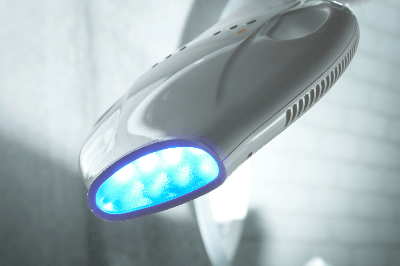What Is a UV Curing System?
 A UV curing system is a device that uses a UV light source as a light source to irradiate ultraviolet rays.
A UV curing system is a device that uses a UV light source as a light source to irradiate ultraviolet rays.
There are three types of UV curing systems (irradiators): spot type, line type, and area type, depending on the UV irradiation range. In addition, they are classified into lamp light source and LED light source according to the type of UV light source. For this reason, a UV curing system is combined with a water-cooled or air-cooled cooling system.
Some UV curing systems are also set with optical equipment, such as lenses, mirrors, and filters, to facilitate the use of UV irradiation light. during UV irradiation, UV light must not be seen directly by the eye because its energy is high enough to decompose organic matter. Also, since ozone is generated, care must be taken in handling the equipment, such as by providing ventilation.
Uses of UV Curing Systems
UV curing systems are used in a variety of fields, taking advantage of the high photon energy of UV light. Specifically, they are used to cure and dry resins and other materials, sterilize microorganisms, remove organic matter, and deodorize with ozone.
There are various types of UV curing systems, and they are used in different ways depending on the intended use. Spot-type UV curing system is suitable for irradiating a narrow area, while line-type and area-type UV light sources are suitable for irradiating materials with a large area, such as wood or plastic plates.
Principle of UV Curing Systems
A UV curing system is a device that irradiates ultraviolet rays generated by a UV light source, which consists of mercury and noble gases trapped as gases in a glass tube between electrodes. The UV light source utilizes the ultraviolet rays generated during discharge.
Heat is generated in the glass tube when the electrodes are energized. The emitter (electron-emitting material) releases electrons held by the heat, and the electrons move along the glass capillary. When the electrons collide with mercury molecules, ultraviolet light can be emitted.
The UV has a specific wavelength due to the action of the glass and the fluorescent paint. Quartz glass and synthetic quartz glass are used as glass materials, the former for high-pressure mercury and metal halide lamps and the latter for low-pressure mercury lamps.
Other Information on UV Curing Systems
1. Wavelength of a UV Curing System
A UV curing system is a product that uses ultraviolet wavelengths. Ultraviolet wavelengths are a type of electromagnetic wave between the wavelength of X (1 to 10 pm), a type of electromagnetic wave similar to radio waves and sunlight, and visible light (380 to 770 nm), a type of electromagnetic wave that can be recognized by human eyes.
The wavelengths of ultraviolet rays are divided into three main categories according to their approximate wavelengths: UV-A, with wavelengths ranging from 315 nm to 400 nm; UV-B, with wavelengths ranging from 280 nm to 315 nm; and UV-C, with wavelengths ranging from 100 nm to 280 nm), sometimes referred to as vacuum ultraviolet (V-UV).
The wavelength of the UV Curing System can be selected according to the application and purpose of the irradiation, so it is important to select the means to be used according to the length of the wavelength.
2. Sterilization With UV Curing Systems
UV curing system sterilization uses the wavelength range of UV-C contained in ultraviolet rays. Depending on the irradiator used for sterilization irradiation, the specific action of the naturally occurring UV curing system is to produce ozone, sterilize, deodorize, and clean the air.
It is believed that irradiating bacteria and viruses with the wavelengths used in sterilization causes a photochemical reaction in the deoxyribonucleic acid (DNA) of the cells, which breaks down the genetic information and kills them. This effect is effective against many bacteria and viruses. This UV-induced DNA degradation reaction also occurs in the human body, but to some extent this is not a problem because the body has a mechanism to repair the degraded DNA.
For these reasons, UV curing systems can be used for sterilization in places that cannot be sterilized with chemical solutions or at medical sites. Usually, low-pressure mercury lamps or high-pressure mercury lamps are introduced as the light source in photo-sterilization. In recent years, the pulsed xenon sterilization method has been applied in the pharmaceutical process and the food industry. This is a technology that has been attracting attention recently because it is much more effective than conventional sterilization methods such as mercury lamps by emitting pulsed light from xenon lamps, which have high sterilizing power.